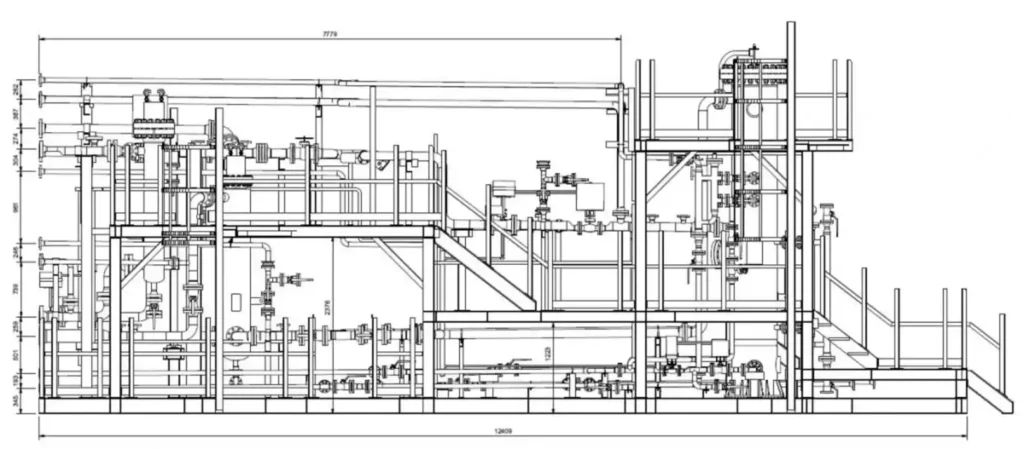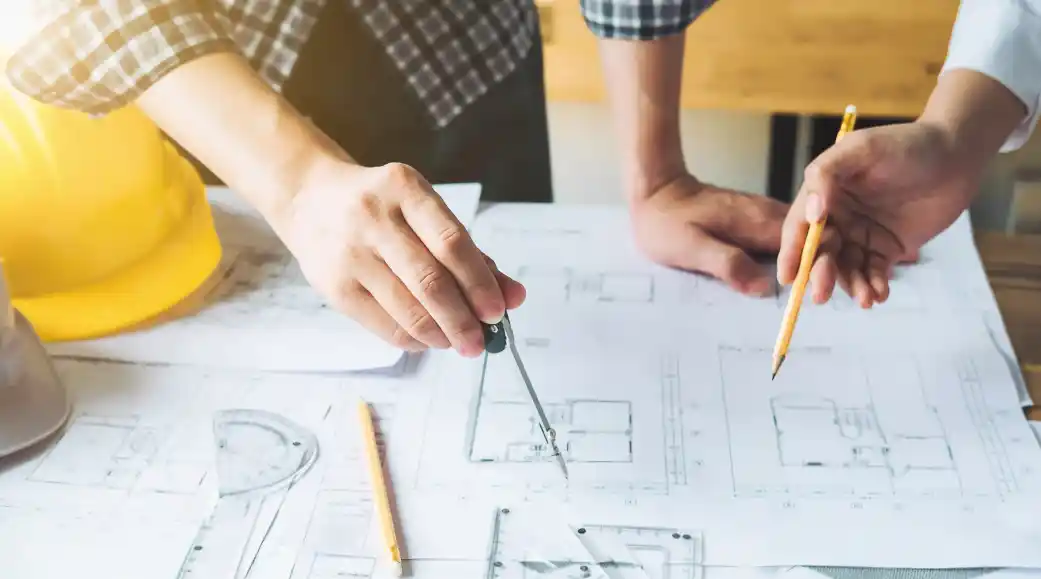In the construction industry, clear and precise documentation is essential for ensuring that projects are completed efficiently and accurately. Construction drawings and shop drawings are the two vital drawing types utilized within the construction sector. Construction drawings share similar initial appearances with shop drawings but perform distinct functional roles at separate times during project execution. This article examines the fundamental distinctions between construction drawings and shop drawings and their vital role in construction projects while explaining their collaborative effect on project life creation.
What Are Construction Drawings?
The official blueprints of construction projects are termed as Construction drawings or working drawings. The drawings deliver an exact representation of the design contents and project components while including all necessary construction elements. Architects and engineers develop drawings that serve to transmit design objectives for contractors as well as subcontractors and additional stakeholders who must know about the design.
Purpose of Construction Drawings

The primary purpose of construction drawings is to guide the construction process. They include comprehensive details such as:
- Site plans
- Floor plans
- Elevations
- Sections
- Details
- Schedules and specifications
These drawings give the construction team a clear roadmap for how to build the structure according to the architect’s vision.
Common Types of Construction Drawings
Some of the key types of construction drawings include:
- Architectural drawings (layout, design, finishes)
- Structural drawings (reinforced concrete, steel framing)
- MEP drawings (mechanical, electrical, plumbing)
- Civil drawings (site development, grading)
Project drawings under this category are commonly known as IFC drawings, which means Issued For Construction drawings. The drawings attain their final form by achieving approval for construction use, which enables their deployment in building construction.
What Are Shop Drawings?
Now, let’s explore what shop drawings are. The creation of Shop drawings or construction shop drawings depends on contractors and subcontractors or manufacturers who establish detailed drawings. The drawings specify production methods for project components and installation steps for their assembly or fabrication.
Shop Drawings Definition
The fundamental goal of shop drawings is to present construction or manufacturing instructions for individual parts before their installation phase. Construction drawings are different from shop drawings since shop drawings contain both exact final measurements and an extensive list of materials together with step-by-step assembly instructions.
What is Shop Drawing?
A shop drawing includes:
- Detailed dimensions
- Material specifications
- Fabrication methods
- Installation instructions

The drawings target special components, specifically including steel structures alongside windows, doors, and HVAC systems, which need custom fabrication. The process of component manufacturing and installation requires shop drawings to achieve proper execution.
What Are Shop Drawings in Construction?
In construction, shop drawings are used by contractors and fabricators to manufacture or assemble the components as specified in the construction drawings. They serve as a bridge between the design and actual construction, ensuring that all elements are constructed accurately and efficiently.
Key Differences Between Construction Drawings and Shop Drawings
Understanding the differences between construction drawings and shop drawings is crucial for project success. Here’s a breakdown of the most important distinctions:
Level of Detail
- Construction drawings present an overall perspective of the complete project through general dimensions that accompany specifications.
- The drawings for shops provide extensive details about specified components through exact measurement documentation combined with material information and construction sequences.
Who Prepares the Drawings?
- Professional architects, along with engineers, generate construction drawings as part of their responsibility to develop and frame complete structures.
- The preparation of shop drawings depends on contractors or subcontractors or fabricators to produce and install particular project elements.
Purpose
- The main objective of construction drawings is to display the complete fundamental arrangement and site organization of the project.
- Shop drawings offer detailed specifications that manufacturers and installers need to create particular components of the project.
Approval Process
- Construction drawings need to obtain project owner approval alongside that of architects and engineers so construction can start.
- The architect and engineer conduct an approval process of shop drawings to verify design specifications and intended planning.
Importance of Construction Drawings in the Building Process
Construction drawings provide essential support that determines the achievement of every construction project. These drawings create the complete project framework, which helps every project stakeholder understand the project design in a unified manner.
Foundation for Construction
When construction drawings are lacking, the construction work cannot move forward. The foundation of the entire project begins with construction drawings that specify all elements that require construction, such as structures and MEP systems.
Coordination and Communication
Construction drawings provide the single official plan, which keeps architects together with engineers and with contractors while subcontractors maintain alignment. Effective collaboration, reduced confusion, and fewer errors occur through this practice.
Legal and Regulatory Requirements
Construction drawings are often used for legal and regulatory purposes, ensuring that the project complies with local building codes and standards. They are also crucial for obtaining permits and approvals.
Importance of Shop Drawings in the Building Process
While construction drawings provide the overall vision, shop drawings bring that vision to life. Here’s why shop drawings are essential:
Precision and Accuracy
Shop drawings present comprehensive information that defines how construction staff should make and position their work elements. The correct alignment of elements during assembly becomes more likely because precise specifications in shop drawings prevent manufacturing mistakes.
Customization
The design specifications needed to fabricate accurate, customized, and complex elements appear in shop drawings for projects. Custom steelwork and HVAC systems require precise information because they cannot be ignored during construction.
Efficiency
The construction workflow becomes more efficient because shop drawings supply detailed instructions about fabrication together with installation procedures. The process delivers components promptly without delays because of the well-developed plans.
Relationship Between Construction Drawings and Shop Drawings
Shop drawings depend on construction drawings for their existence, although they function as different sets of information. A more detailed document derived from construction drawings forms the nature of shop drawings.
How They Complement Each Other
Construction drawings make the general project plan. while shop drawings add detailed information about dimensions together with materials and fabrication techniques. The accuracy in shop drawings depends on how clearly the construction drawings are presented, and the construction drawings require similar clarity for accuracy.
Coordination and Communication Between Teams
A project requires ongoing coordinated activities between design members (including architects and engineers) who work with construction personnel (comprising contractors and fabricators) to succeed. Shop drawings need approval, which verifies that they correctly represent the original design blueprint from construction drawings.
When Are Shop Drawings Required?
Shop drawings are required in various situations, particularly for custom or complex components. Some examples include:
- Steel framing for structural elements
- HVAC systems that need detailed installation instructions
- Custom cabinetry or furniture that must be precisely fabricated
- Prefabricated components, like precast concrete or modular building systems
In these cases, shop drawings ensure that these elements are fabricated and installed correctly, according to the project specifications.

Common Mistakes and Issues
While construction drawings and shop drawings are critical to a successful project, mistakes can still happen. Here are some common issues:
Issues with Construction Drawings
- Lack of detail or clarity, leading to confusion during construction
- Misinterpretation of dimensions, materials, or installation methods
Issues with Shop Drawings
- Non-compliance with the original construction drawings
- Inaccurate or incomplete details that cause fabrication or installation problems
How to Ensure Accuracy and Compliance
To avoid issues and ensure a smooth construction process, both construction drawings and shop drawings must be thoroughly reviewed and approved. Collaboration tools like BIM (Building Information Modeling), can assist in ensuring that both sets of drawings are aligned and compliant with the project specifications.
Conclusion
Both construction drawings and shop drawings are essential for a successful construction project. While construction drawings provide the overall framework and vision, shop drawings ensure that the specifics of the design are accurately fabricated and installed. By understanding the key differences and uses of each, contractors and architects can work together more efficiently and avoid costly mistakes.





